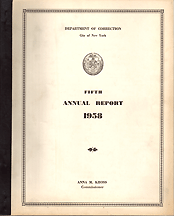 |
As Excerpted in NYCDOC'sAbout a year after |  |
Correction Commissioner Anna M. Kross, who championed BOC's creation, reprinted excerpts in her 1958 annual report. They are reproduced here. |
 |
As Excerpted in NYCDOC'sAbout a year after |  |
Correction Commissioner Anna M. Kross, who championed BOC's creation, reprinted excerpts in her 1958 annual report. They are reproduced here. |
Correction Board chairman Carl M. Loeb, Jr. addresses the Board of Estimate Nov. 18, 1958 on DOC's proposed 1959 capital budget. He uses a chart similar to one later included in BOC's frist report. |  |
 |
Chart (above) from BOC's first report represented the actual and projected average NYC prison population by year. |
TO THE BOARD OF ESTIMATE [Extracted from NYC DOC 1958 annual report.]
Carl M. Loeb, Jr., Chairman of the Board of Correction, City of New York, made the following comments at the Board of Estimate Public Hearings (November 18, 1958) in support of the 1959 Departmental Capital Budget: "To substantiate our request, which I will make in a couple of minutes, I want to show you where we can expect the population of the city prisons to go in the next 10 years. "I show you a chart projecting the average prison population recorded in Mr. Preusse's report last April. Noteworthy are the following items. First of all, this curve does not take into account the increasing percentage of youth between 15 and 25 which is anticipated in the next five or ten years; secondly, any future recessions, which were virtually non-existent in the years determining the pitch of this line, would substantially raise the anticipated number of prisoners. This very conservative pitch forecasts about 265 more prisoners each year. "According to the proposed building plans from 1959 through 1966 the following are the contemplated additions and subtractions in our capacity. "In 1960, the new Queens House of Detention and the Bronx addition, totalling 764; in 1961 Rikers Island with 480 capacity; in 1965 the Adolescent Remand Shelter at Welfare Island with 1,100 capacity; in 1966 the Women's Prison and Detention House at Welfare Island with 700 (to replace a building condemned 25 years ago), and in 1968 the Workhouse at Rikers Island with 1,200 capacity. During this period, however, we lose the following buildings during the years indicated, and I list the number of inmates in them on November 14th. Raymond Street in 1960, with 740 prisoners last week; Queens in 1963 with 278, and the Women's Prison in 1966 with 484, and the Workhouse at Hart Island in 1968, now holding 1,277.
"The main reason for the disturbances which have beset the department of late is overcrowding. Last Friday we had 8,229 in jail, with a rated capacity of 5,933. If all the buildings which the Planning Commission has recommended for completion by 1966 were NOW available (capacity 3,044) and no buildings were evacuated, we would have just enough space comfortably to house our present prisoners. "During this period, however, we also lose buildings now housing 1,502 prisoners -- and we expect an increase of at least 2,120, so that we will, at best, be overcrowded by 2,874 in 1966. The Hart Island closing in 1968 increases overcrowding to 4,681. "In view of the above, we ask that all possible effort be expended to complete the buildings far ahead of schedule, and that our funds, under C-75, for improvements be reinstated to the requested amount. "It is sad but true that building programs for prisoners never get going until demoralizing and dangerous riots take place. We are just lucky to have had only minor disturbances in the city jails in 1958. Let's at least get properly started before matters get worse than they are now." | |||||